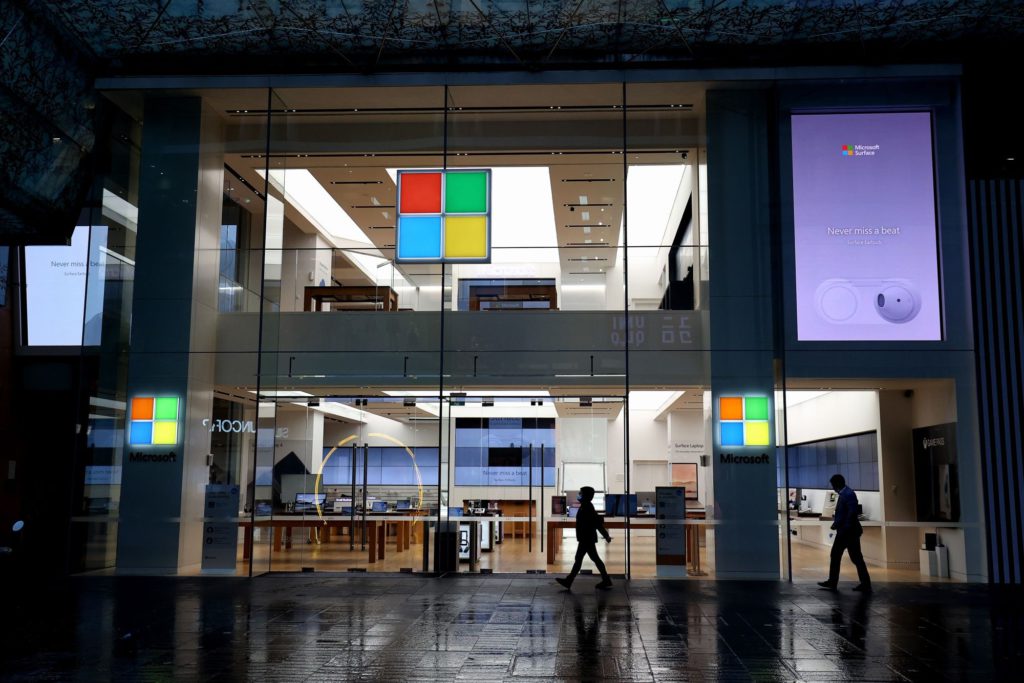Microsoft Corp. posted its weakest quarterly revenue growth in five years, throttled by the surging U.S. dollar and a slump in sales of Windows software to personal-computer makers. Shares slipped in late trading.
(Bloomberg) — Microsoft Corp. posted its weakest quarterly revenue growth in five years, throttled by the surging U.S. dollar and a slump in sales of Windows software to personal-computer makers. Shares slipped in late trading.
Sales in the first quarter, which ended Sept. 30, rose 11% to $50.1 billion, the software maker said Tuesday in a statement. Net income was $17.6 billion, or $2.35 a share. While both numbers topped analysts’ average estimates, revenue from Microsoft’s closely watched Azure cloud-computing services decelerated to 35% — partly because of foreign-currency exchange rates.
Excluding the impact of the rising dollar, Azure sales rose 42%, below some predictions. Demand has held up for Azure services, which run and store businesses’ software applications, and web-based versions of Office productivity programs, even as customers pare some other corporate spending while the global economy teeters on the brink of a recession. Still, Microsoft gets almost half of its revenue overseas. The U.S. dollar soared to new highs against a basket of foreign currencies last month, meaning Microsoft’s international sales were worth less when brought back home.
Revenue from sales of Windows software to PC makers swooned 15% in the recent period. That mirrored the quarterly contraction in PC shipments reported this month by market research firm IDC, which cited “cooling demand and uneven supply.”
“The tone has definitely changed,” said Dan Morgan, a senior portfolio manager at Synovus Trust Co. “We’ve started to get a big change-up in software spending surveys — there’s a general consensus of ‘hey, you know, the economy is slowing down and we’re watching our expenses.’”
Microsoft shares slipped about 2.2% in extended trading following the report, after rising to $250.66 at the close in New York. While the stock jumped 51% in 2021, it has fallen 25% so far this year amid a rout in large technology stocks. During the recent quarter, the company’s shares declined 9.3%, while the Standard & Poor’s 500 Index dropped 5.3%.
On average, analysts had estimated fiscal first-quarter sales of $49.6 billion and profit of $2.29 a share, according to a Bloomberg survey. Demand remained strong for cloud services, with Office 365 sales to businesses performing slightly better than expected, and the majority of large customers that signed up for Microsoft 365 licenses opting for the higher-end version, Chief Financial Officer Amy Hood said in an interview.
The company also saw growth in large and long-term contracts for Azure, she said. At the same time, economic uncertainty is hurting sales of PCs as well as advertising revenue, which affected Microsoft’s Search and LinkedIn businesses.
“While we are not immune, of course, from macroeconomic impacts, we really feel good about the businesses we are investing in, the strong growth rate, the position in the market,” Hood said.
Total cloud revenue in the period rose 24% to $25.7 billion, Microsoft said in slides posted on the company’s website. Gross margins in those businesses widened because of an accounting change; excluding that change, margins would have narrowed by 1 percentage point because Microsoft is getting more sales from Azure, which generally has higher costs. Microsoft also noted that cloud service costs are rising because of increasing energy prices.
Hood said higher energy prices are increasing the cost of delivering cloud services, mainly in Europe — an issue that is having a greater impact than Microsoft had expected. She anticipates that will continue into the second half of the company’s fiscal year.
Sales in the productivity group, largely Office software, rose to $16.5 billion, above the $16.1 billion average estimate of analysts polled by Bloomberg. Intelligent Cloud revenue, made up of Azure and server software, came in at $20.3 billion, matching projections. In More Personal Computing, consisting of businesses like Windows, Surface devices and Xbox, sales were $13.3 billion. That compares with the $13.1 billion average estimate of analysts.
Some analysts have cautioned that Microsoft’s annual revenue forecast, which it will update later on Tuesday, is at risk. In a research note before the report, Guggenheim analysts questioned the company’s ability to maintain full-year guidance of double-digit revenue growth if the dollar continues to strengthen and economic conditions get worse.
(Updates with comments from CFO in eighth paragraph.)
More stories like this are available on bloomberg.com
©2022 Bloomberg L.P.











